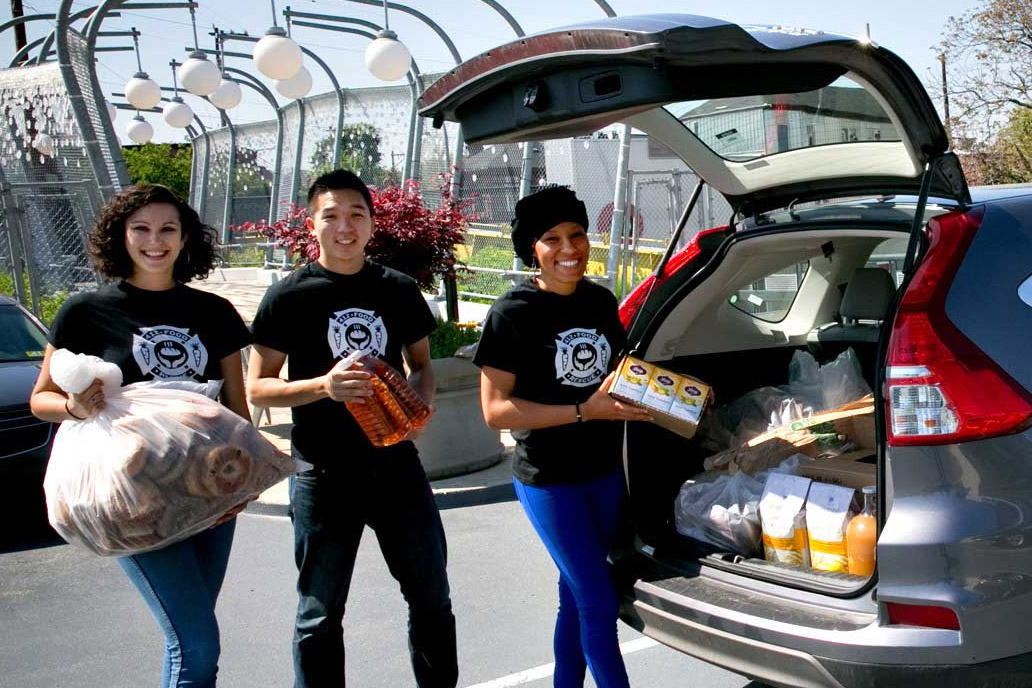Chances are, all that leftover food from your office party or wedding might end up in a dumpster—and eventually the landfill. Unless a hero swoops in.
Because it’s the 21st century, that hero is a new app. It’s called Food Rescue Hero, and 412 Food Rescue—a nonprofit in Pittsburgh—has been working with local developers over the past 18 months to get it off the ground.
“In the past year, we’ve rescued over 750,000 pounds of food—and that’s a drop in the bucket,” says Jennifer England, 412 Food Rescue’s Director of Operations.
England spends a lot of time on her phone—coordinating donations from places like food distributors (which may have an extra crate of oranges) to shelters or other groups where people need food. The organization mostly deals with fresh food, and they have a refrigerated truck and a part-time driver to take care of the logistics.
LISTEN: How You Can Use Your Phone to Fight Hunger
But sometimes, perfectly good food falls through the cracks. Think of that tray of deli sandwiches that the caterer got wrong or a couple pans of leftover restaurant food. “That’s a really small amount to send a truck for,” England says. “That’s actually kind of wasteful.” That’s where the Food Rescue Hero app comes in. Now, once England secures a place that will take a food donation, she can simply use the app to notify their growing network of more than 450 volunteers that there is a delivery opportunity they can claim. They call it “Uber for food recovery.”
“The app will tell them you’re picking up at this location and delivering to this location,” England says. It also tells you what you’ll be picking up, so you don’t show up with your subcompact to pick up 500 watermelons. “They can make the decision whether it works for them or not.”
England says volunteers who download the app for iPhone or Android can expect to get about five notifications a day for delivery opportunities. The team is still working through some snags with the app, but right now, it’s helping with about half of their volunteer pickups and deliveries. Shannon Baldridge from Verona has used it to volunteer a few times now. Baldridge works from home in marketing and web design, so his schedule is pretty flexible, and he’s an ideal candidate for mid-day runs.
“It is eye opening to see how much food is out there that would have ended up in a dumpster,” Baldridge says. “So if I’m in the neighborhood or if I have nothing going on or just want to get that feel-good feeling, it’s a win-win.”

412 Food Rescue’s Jennifer England calls their Food Rescue Hero app the “Uber for food recovery.” Photo: Kara Holsopple
An estimated 40 percent of food in the U.S. ends up in landfills, which produces methane gas and contributes to climate change.
“Then the other side of that is people going hungry,” Baldridge says. “It’s crazy to think about, you know?”
412 Food Rescue partners with about 225 recipient organizations, and they’re not all traditional food pantries and soup kitchens working to end hunger. The Housing Authority of the City of Pittsburgh receives donations regularly at their 11 high rises and six family communities.
Michelle Sandidge, the chief community affairs officer for the Housing Authority, says the tenant council at each of the sites works with resident services to distribute the food. When a case of lettuce comes in, they portion it into Ziploc bags so residents can carry it home easily. She says, in the past, they would have at least five to seven families a month who were without food. That’s changed in the year they’ve worked with 412 Food Rescue.
“We have not had one call for emergency activity for food distribution, because everybody is well taken care of.”
An estimated 40 percent of food in the U.S. ends up in landfills, which produces methane gas and contributes to climate change.
She says the quality of the food is exceptional, and so is the variety (she’s seen everything from salmon to avocados). Sandidge says price and location are barriers for many residents when it comes to accessing fresh food. But another benefit of these donations, besides nutrition, is the shared community that’s developed around the food—especially for seniors.
“There are other people there who can tell you, ‘Let me tell you how you can do something with eggplant,’” she says.
412 Food Rescue’s Jennifer England says the Food Rescue Hero app makes getting the right food to the right people in a timely way a lot more efficient. To her, it feels like a miracle.
“We can reach a lot more people,” she says. “We can get a lot more people involved and sort of democratize the process.”
England also says this is just the first phase of the app. They hope to create a model that is replicable and scalable to make an impact on food waste and hunger on a larger scale.
“We’re creating technologies that can be deployed anywhere so that anybody can do this.”

